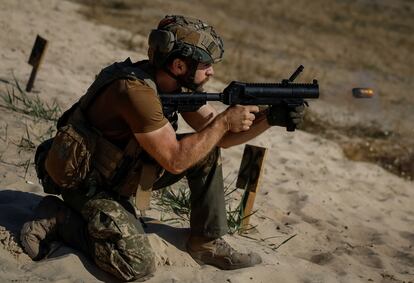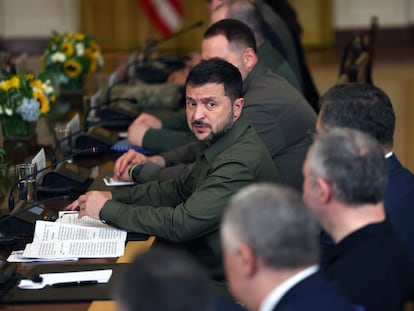Ukraine wants to be the largest arms producer in the West
Zelenskiy has announced a weapons manufacturing agreement with 38 multinational companies. He wants his country to become ‘the arsenal of the free world’


This past Saturday, President Volodymyr Zelenskiy stated that he wants Ukraine to become the largest arms producer in the West. He said this at a congress in Kyiv, before an audience made up of executives from more than 250 weapons companies, both domestic and foreign.
The Russian invasion has left the country dependent on supplies from its NATO allies. However, it has also triggered a rapid technological evolution in the private sector, which has been working to provide new weapons to Ukrainian troops — drones, in particular. The government in Kyiv wants to take advantage of this experience to lay the foundation required to become a future military superpower.
Zelenskiy greeted the representatives of the main companies from the weapons industry with these words: “I am pleased to welcome those who are ready to build the arsenal of the free world, with Ukraine and in Ukraine…. a powerful and modern arsenal that no aggressor stands a chance against.” Zelenskiy has announced the creation of an alliance of multinational companies, with the ultimate goal of setting up armaments factories in Ukraine. According to the country’s Ministry of Foreign Affairs, 38 companies from 19 countries have joined this alliance so far. The ministry has also detailed the signing of 20 new agreements with international suppliers of components for Ukrainian manufacturers of drones, ammunition and armor.
So far in the war, Ukraine’s allies have committed military aid valued at around $100 billion, according to data from the Kiel Institute for the World Economy in Germany. Yet, the Ukrainian demand to stop the invader exceeds the production capacity of its NATO partners. On September 18, in an interview with CBS, Zelenskiy explained that each side fires an average of 40,000 artillery shells per day. But, before the war in Ukraine, the United States was producing only 14,000 shells each month. In August, The Washington Post reported that, during the conflict, the American armaments industry has raised output to 20,000 shells per month.
There are already precedents for joint armaments production agreements between Ukraine and allied countries. For instance, in November of 2022, the state company Ukroboronprom announced a pact with six countries, including Poland, France, the Czech Republic and Denmark, to develop new weapons and manufacture body armor, mines, and 152mm rounds for Soviet-era howitzers. However, these agreements focused primarily on production outside of Ukrainian territory, due to the risk of Russian attacks. For this reason, several of the most relevant Ukrainian drone companies have opened production centers in Poland. This past Thursday, French Defense Minister Sébastien Lecornu confirmed from Kyiv that the French government wants to analyze the types of weapons that France and Ukraine can jointly produce.
More weapons, less grain
Oleksandr Kamyshin, Ukraine’s minister of Strategic Industries, has made it clear that the future of his country lies in the armaments industry, beyond the needs of the ongoing war. He reiterated this on September 9, during the annual conference of the Yalta European Strategy group. Kamishin said that, if Ukraine has been known until now as one of the world’s largest grain producers, it will now be known for its weapons industry: “When the war is over, it will be smarter to export weapons than agriculture. One kilo (2.2 pounds) of defense industry exports is equivalent to 20 agricultural tons [in terms of revenue]. Being the arsenal of the free world is a good alternative to being the bread basket of Europe.”
“Betting on the arms industry is the best thing we can do in the long term,” the minister stressed. “In agriculture, we have shown that we have the lowest-cost production and the lowest-cost logistics. The defense industry will be Ukraine’s new agriculture.”
This strategy matches the one employed by the international reference that Zelenskiy most often cites when he speaks about what kind of future Ukraine should aspire to: Israel. “It’s exactly what we need: a model that includes weapons, technology, training, financing,” the president said, in an interview on Ukrainian television. Strengthening the domestic arms industry is essential, the president added, “because, at some point, we have to accept that we could be left alone.”
Zelenskiy himself admitted on September 19, while addressing the United Nations General Assembly, that there were ongoing international attempts to work with Russia to end the war, regardless of the Ukrainian opinion. Another alarm signal came last week, when Polish Prime Minister Mateusz Morawiecki announced that his priority is to renew his national arsenal and not deliver new arms packages to its neighboring country. Poland has been one of Ukraine’s strongest allies, but the two governments have been locked in a bilateral conflict over Poland’s veto on Ukrainian grain exports, in an attempt to protect its farmers. Morawiecki’s veiled threat can be understood in this context, but it also shows Ukraine’s fragile position: its existence depends on international aid.
The advantage that Ukraine has on its path to becoming a military superpower is that “from drone production to demining, it’s progressing at the speed of light,” according to NATO Secretary General Jens Stoltenberg, who spoke with the media in Kyiv this past Friday. Ukraine also isn’t starting from scratch, as the country inherited a powerful defense industrial network from the Soviet Union. But in the field of defense, it has been an international actor operating below its capabilities. Until 2014, successive governments didn’t bother to promote the sector. Then, the war in Donbas against the region’s separatists, who were supported by Russia, highlighted Ukraine’s many military deficits. This led to a progressive modernization of its Armed Forces, which accelerated upon Zelenskiy’s election in 2019.
In his speech on Saturday, Zelenskiy gave an example of this progress by noting that the Ukrainian Navy had built its first fleet of marine drones. In fact, the Ministry of Defense has developed several types of bomb-carrying drones capable of hitting the Russian Black Sea Fleet hundreds of miles off the coast of Ukraine — either on the high seas or in Russian ports — or infrastructure, such as the Kerch Bridge in Crimea, which is the only bridge connecting Russia with the Crimean Peninsula.
Another paradigm of Ukrainian weapons development is the Neptune marine missile, which has been transformed to the point of being able to also hit land targets as far as 190 miles away. Kyrylo Budanov, head of intelligence services at the Ministry of Defense, explained in a September 23 interview with The War Zone that the drawback of the Neptune missile is that Ukraine still doesn’t have sufficient industrial capacity to produce a large number of units.
The same issues have limited the potential of the Ukraine-developed Bohdana self-propelled howitzers or the 155mm rounds — the main artillery shells used by NATO-provided weapons — which are manufactured, to a limited extent, within Ukrainian territory. The invaded country’s industry is constantly threatened by Russian bombings. Another setback is that a good part of Ukraine’s metallurgical sector is located in territories occupied by Russia.
This past Saturday, at the defense forum in Kyiv, Minister of Foreign Affairs Dmytro Kuleba assured attendees that the demand to buy Ukrainian weapons is resurfacing again. While he acknowledged that his government cannot export weapons at the moment as it needs everything it produces to defend itself against Russia, he also noted that certain African governments (which he didn’t wish to name) had expressed interest in buying Ukrainian weapons and having them manufactured in their countries. His words are also a warning to Moscow, insinuating that the Kremlin isn’t the only geopolitical actor capable of achieving strategic influence in Africa.
Sign up for our weekly newsletter to get more English-language news coverage from EL PAÍS USA Edition
Tu suscripción se está usando en otro dispositivo
¿Quieres añadir otro usuario a tu suscripción?
Si continúas leyendo en este dispositivo, no se podrá leer en el otro.
FlechaTu suscripción se está usando en otro dispositivo y solo puedes acceder a EL PAÍS desde un dispositivo a la vez.
Si quieres compartir tu cuenta, cambia tu suscripción a la modalidad Premium, así podrás añadir otro usuario. Cada uno accederá con su propia cuenta de email, lo que os permitirá personalizar vuestra experiencia en EL PAÍS.
¿Tienes una suscripción de empresa? Accede aquí para contratar más cuentas.
En el caso de no saber quién está usando tu cuenta, te recomendamos cambiar tu contraseña aquí.
Si decides continuar compartiendo tu cuenta, este mensaje se mostrará en tu dispositivo y en el de la otra persona que está usando tu cuenta de forma indefinida, afectando a tu experiencia de lectura. Puedes consultar aquí los términos y condiciones de la suscripción digital.
More information
Archived In
Últimas noticias
Most viewed
- Reinhard Genzel, Nobel laureate in physics: ‘One-minute videos will never give you the truth’
- Oona Chaplin: ‘I told James Cameron that I was living in a treehouse and starting a permaculture project with a friend’
- Pablo Escobar’s hippos: A serious environmental problem, 40 years on
- Chevy Chase, the beloved comedian who was a monster off camera: ‘Not everyone hated him, just the people who’ve worked with him’
- Why we lost the habit of sleeping in two segments and how that changed our sense of time









































